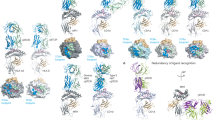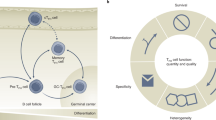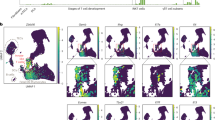Abstract
THE Ly phenotype of T cells which cooperate with B cells in the production of antibody has been described as Ly 1+2− (refs 1 and 2). Helper T cells are distinct from cytotoxic T cells (Ly 1− Ly 2+)1,2 and suppressor T cells (Ly 1−2+)3,4. In tissue culture, helper activity does not depend on the presence of intact T cells but can be mediated by cell-free supernatants from stimulated T cells. Stimulation with antigen induces the release of antigen-specific helper factors5,6 as well as factors which support antibody response against unrelated antigens7. Factors similar or identical to the latter are produced by splenic T cells in response to alloantigens8–10 and concanavalin A11. It is tacitly assumed that the mechanism by which helper T cells collaborate with B cells in the production of antibody is to be attributed to the release of these mediators. We report here that with respect to their Ly phenotypes, T cells which release T-cell replacing factor (TRF)8 in response to alloantigen belong to the same subpopulation of T cells as helper cells.
This is a preview of subscription content, access via your institution
Access options
Subscribe to this journal
Receive 51 print issues and online access
$199.00 per year
only $3.90 per issue
Buy this article
- Purchase on SpringerLink
- Instant access to full article PDF
Prices may be subject to local taxes which are calculated during checkout
Similar content being viewed by others
References
Kisielow, P., et al., Nature, 253 219–220 (1975).
Cantor, H., and Boyse, E. A., J. exp. Med., 141, 1376–1399 (1975).
Feldmann, M., Beverly, P. C. L., Dunkley, M., and Kontiainen, S., Nature, 258, 614–616 (1975).
Jandinski, J., Cantor, H., Tadekuma, T., Peavy, D. L., and Pierce, C. W., J. exp. Med., 143, 1382–1390 (1976).
Feldmann, M., and Hasten, A., J. exp. Med., 136, 722–736 (1972).
Munro, A. J., Taussig, M. J., Campbell, R., Williams, H., and Lawson, Y., J. exp. Med., 140, 1579–1590.
Dutton, R. W., et al., Prog. Immun., 1, 355–362 (1971).
Schimpl, A., and Wecker, E., Adv. exp. Med. Biol., 29, 179–182 (1972).
Armerding, D., and Katz, D. H., J. exp. Med., 140, 19–37 (1974).
Harwell, L., Kappler, J. W., and Marrack, P., J. Immun., 116, 1379–1384 (1976).
Mishell, R. I., and Dutton, R. W., J. exp. Med., 126, 423–433 (1967).
Author information
Authors and Affiliations
Rights and permissions
About this article
Cite this article
PICKEL, K., HÄMMERLING, U. & HOFFMANN, M. Ly phenotype of T-cells releasing T-cell replacing factor. Nature 264, 72 (1976). https://doi.org/10.1038/264072a0
Received:
Accepted:
Issue date:
DOI: https://doi.org/10.1038/264072a0



